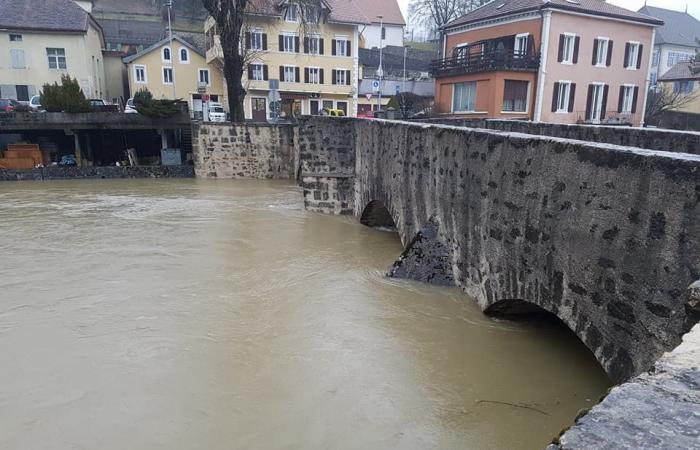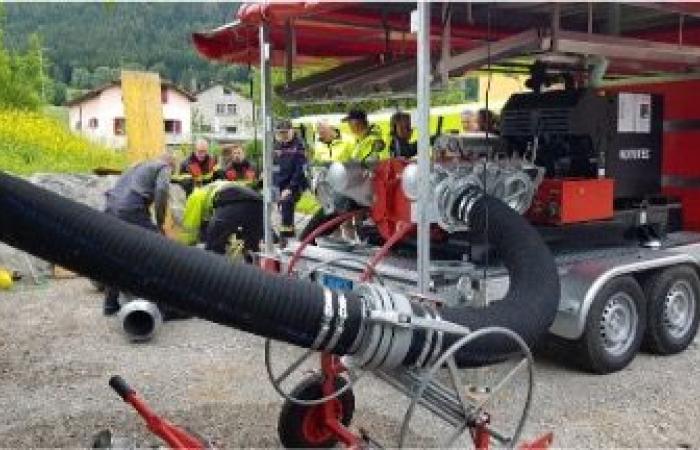To reduce the risks and damage in the event of rising water levels in the Areuse in the village of Travers, the municipality of Val-de-Travers has taken several constructive and preventive measures and established an intervention plan.
For a long time, the village of Travers has experienced flooding on both sides of the stone bridge which crosses the Areuse, on the left bank upstream of the latter and on the right bank downstream.
In the years 1948 to 1953, work to correct the watercourse had already been carried out upstream of the locality to reduce the risks. Then, at the end of the 1990s, major flood protection works were undertaken on the banks of the Areuse within the village itself: they consisted of raising walls and creating dikes. and in terrain models. Despite these developments, numerous floods have still been recorded since then, the last events dating from November and December 2023.
The work, ordered at the time by the State of Neuchâtel, was financed 25% by the municipalities of Travers and Noiraigue. The Canton then also undertook cleaning of the river bed approximately every 10 years in the village of Travers.
In 2019, the municipality of Val-de-Travers acquired a framework credit of more than 20 million francs to improve the overall functioning of its water evacuation networks and in 2023 undertook the implementation implementation of a new series of specific measures in Travers with the aim of reducing the risk of flooding and increasing safety for local residents on both banks of the Areuse.
The scope of the resources that have been committed mainly concerns the water evacuation networks which are under municipal jurisdiction. Careful investigations carried out by an engineering office into the operation of the networks revealed that they needed to be reinforced with the main objective of reducing their points of contact with the river and equipping them with reliable protection devices.
On both banks, new collectors have been created and now rainwater is concentrated towards single discharge points into the river, equipped with valves which close in the event of rising water levels.
On the left bank, the wastewater connections of three buildings were modified to make them independent of the village’s main collector which runs along the river, thereby eliminating the risk of backflow inside the buildings.
In a few months, it is still planned to carry out a protective development on the right bank, on rue des Deux-Fontaines, to allow the installation of cofferdams which will be able to contain the next flood at the same level as that of the dike. Finally, work to seal wastewater collectors will be carried out.
Two mobile pumping units capable of delivering up to 7,500 liters per minute were ordered almost a year ago and were delivered at the beginning of June to the Val-de-Travers fire defense and rescue service. They must allow water to be raised over the protective walls. Pits were also made at the lowest points of each bank and were specially equipped to facilitate the implementation of intervention services.


The emergency services also now have a surveillance and intervention plan – the first in the canton – which was developed to structure and organize the tasks of the staff involved. This plan, accompanied by mission sheets for each event, will allow all the services concerned to collaborate as effectively as possible. The plan and the sheets will be updated and adapted as experiences become available.
The emergency services can also rely on a water level scale as well as a device for continuously measuring the level of the Areuse which have been installed near the Travers bridge. The alerts issued by MétéoSuisse, hydrological data and forecasts from the Federal Office for the Environment (FOEN) concerning the Areuse in Saint-Sulpice (www.hydrodaten.admin.ch) as well as the hydrological monitoring of the Canton of Neuchâtel which concerns many waterways (www.vhne.ch) complete the tools.
The budget allocated for the entire system is of the order of 1.7 million francs, an amount co-financed for some of the measures up to 70%, for protection against floods, by the Canton and the Confederation. . Other measures concerning rainwater networks are supported up to 40% through the cantonal water fund.
Despite these substantial and necessary investments made by public authorities, it is important to emphasize that zero risk will unfortunately not exist and that natural dangers remain and will sometimes remain out of control.
If you have spotted a spelling error, please let us know by selecting the text in question and pressing Ctrl + Enter or by email.








